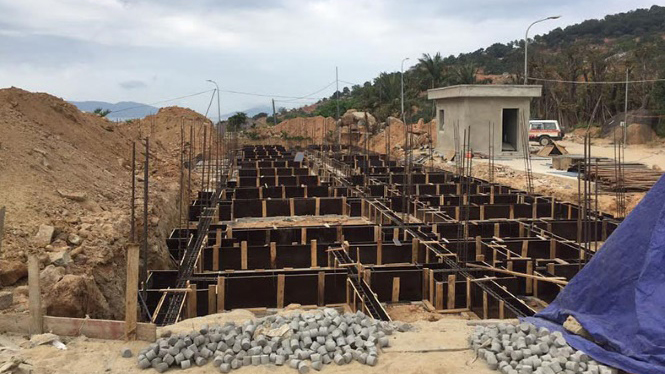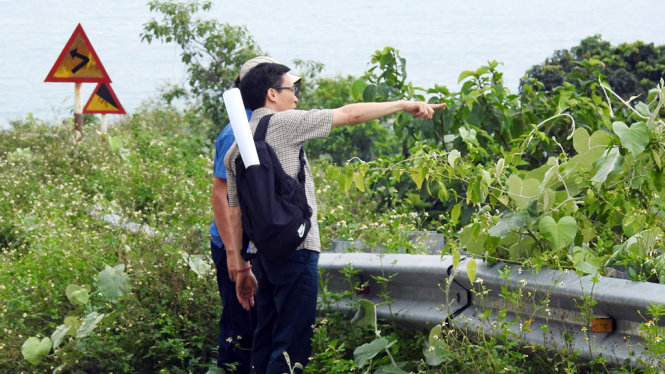
Son Tra
What will be left for future generations?
Located on the edge of Da Nang, one of the most robust cities in the central region, Son Tra Peninsula has kept intact its own tranquility and pristine nature for visitors, who have been greatly attracted to the area’s evergreen forest, crowded population of wildlife flora and fauna, and beautiful beaches. However, the explosion of development activities, especially in tourism, in recent years has caused tremendous pressure and threatens the sustainability of the natural ecosystems on the peninsula.
As a 13.5 km mountain range northeast of Da Nang and bordered by the sea in three directions, Son Tra Peninsula covers over 4,400 hectares (10,880 acres) and rises to 700 meters at its peak.
The peninsula is dubbed as a green lung as it not only produces pure oxygen but also serves as a giant shield protecting the coastal city against storms and cyclones coming in from the sea. Son Tra is also seen as a magical eye looking at the East Sea. It is said that from Son Tra, one can even watch airplanes depart and take off from Cat Bi airports in the northern port city of Hai Phong.
Location of Son Tra Peninsula
Son Tra Peninsula is home to 360 species of fauna, including a rare native species of primates called red-shanked doucs, which are known locally as ‘the queen of all primates’ and have been listed in the Red Book of Vietnam as they are at a high risk of extinction.
Although red-shanked doucs can be found in three areas in Vietnam, including the Phong Nha – Ke Bang National Park in Quang Binh province, Chu Mom Ray National Park in the Central Highlands province of Kon Tum, and Son Tra Peninsula, the latter is the most accessible place to observe the primates in their natural environment.
There are approximately 1,335 red-shanked doucs (Pygathrix nemaeus) and 237 troops living on the Son Tra Peninsula, according to GreenViet Biodiversity Conservation Center in Da Nang, with their habitat covering around 3,133 hectares. The majority of recorded red-shanked doucs are located in the northern part of the peninsula.
In addition to its myriad of fauna, research has confirmed that Son Tra is home to 985 species of vascular plants and nearly 300 species of terrestrial vertebrates. It is also a large flower garden that blooms all year round with assorted types of flowers.

A bird on Son Tra Peninsula
Standing on the top of Son Tra, visitors can admire a spectacular panorama of Da Nang and its surrounding areas: the Giant Marbles Mountain to the south, the Cham islet to the southeast, the dynamic city of Da Nang to the west, and Hai Van range to the north.
The seas surrounding the Son Tra Peninsula also have important coral and seagrass ecosystems, with 191 species of reef hard corals, 72 seaweed species and three seagrass species, making it an ideal location for fans of diving and snorkelling.
On the foot of Son Tra are beautiful sandy beaches and tourists attractions such as Linh Ung Temple and Dong Dinh Arts and Culture Museum.
Having a natural forest ecosystem associated with the sea, Son Tra is bestowed by Nature Mother as the only place in Vietnam home to ecological values in the heart of a modern city, making it a unique and must-see place for visitors to the country.
The burst of tourism projects on Son Tra peninsula and the controversial zoning of the area have placed tremendous pressure on the forests and ecosystem, as well as the viability of endangered animals.
In September 2008, the total area of Son Tra Natural Reserve was cut down to 2,950 hectares, from its original 4,430 hectares, according to planning approved by Da Nang city People’s Committee.
Original plan
4,430ha
Adjusted plan
2,950ha
Prior to May 2013, the city authorities had also given the green-light for hotel and resort projects which would increase the total of hotel rooms on Son Tra by 5,000.
In September 2016, the Government approved a master plan on developing Son Tra National Tourist Site by 2025 with a vision to 2030. Under the plan, an additional 1,056 hectares on Son Tra, which doesn’t belong to the area that was previously approved by the city authorities in 2008, will be converted to serve tourism projects.
The projects will allow a total accommodation capacity of 1,600 rooms on the peninsula by 2030, which is much lower than the figure of 5,000 targeted by the city authorities.
Complicating the matter, on March 14 this year, a Da Nang citizen uncovered the construction site on Son Tra near Tien Sa port, which then quickly drew a lot of attention from the press.

A construction site on Son Tra
Five days later, Chairman of Da Nang city People’s Committee Huynh Duc Tho ordered the suspension of the project, which turned out to not be licensed yet.
Shortly after the decision was announced, on March 21, the Da Nang Tourism Association (DTA) led by its Chairman Huynh Tan Vinh submitted a petition calling on the central overnment to reconsider the planning voicing their concern that Son Tra will be threatened by tourism projects. They affirmed that the existing accommodations on Son Tra, which has a combined sum of 300 rooms, is enough for the development of the planned tourism zone.
On April 4, the Government Office issued an urgent document conveying Prime Minister Nguyen Xuan Phuc's order for coordination between the Ministry of Culture, Sports and Tourism and the Da Nang People’s Committee to address the DTA’s petition.
At the end of May, Deputy Prime Minister Vu Duc Dam made a first-hand examination of the peninsula. At a meeting with Da Nang city authorities, relevant ministries and sectors following the trip, he requested a three-month delay on the implementation of a plan to develop a tourist area on the peninsula.

Deputy PM Vu Duc Dam makes a first-hand examination of the peninsula.
At the question and answer session at the 14th National Assembly (NA)’s third meeting in Hanoi, on June 14, many NA deputies raised their concern regarding the zoning plan of Son Tra peninsula as well as the alarming deforestation status there.
Minister of Culture, Sports and Tourism Nguyen Ngoc Thien stressed the ministry’s stance of welcoming opinions from relevant parties, while giving priority to promoting sustainable development, protecting and preserving biological diversity, and ensuring the interests of the people of Da Nang.
Deputy PM Vu Duc Dam stressed that the central government and the Prime Minister are consistently committed to sustainable development; and if there are any uncertainties regarding sustainability, any project will be halted until it meets eligible conditions.
The Prime Minister will give a decision after hearing the final opinion from Da Nang and all concerned parties. In the case of not developing tourism in Son Tra, the planning will be removed from the list of 47 national tourist complexes with a signed document by the PM, Deputy PM Dam confirmed.

A construction site on Son Tra

Deputy PM Vu Duc Dam makes a first-hand examination of the peninsula.
The issue of conservation had been raised even before Son Tra was put under spotlight. Son Tra Nature Reserve was first established in 1989 on the basis of the conversion of Son Tra Peninsula’s prohibited jungle.
In addition, the red-shanked doucs, a rare and endangered Indochinese species, were protected under two government decrees issued in 2006 and 2013.
The explosion of development activities, especially tourism, in recent years, has caused tremendous pressure and threatened the sustainability of the Son Tra Peninsula’s natural ecosystem, thus posing the need to preserve the precious Son Tra for future generations.
Implementing the instruction by the Prime Minister on the development of a Son Tra sustainable conservation plan, a series of seminars and specialised meetings have been held to collect comments and suggestions on tourism development in conjunction with Son Tra conservation work. Officials, policymakers, experts and local people have participated in order to develop suitable solutions to preserve Son Tra in the context of tremendous pressure from development.
They agreed that Son Tra Peninsula is a unique ecological region of Vietnam and that the Prime Minister should stipulate the preservation of natural ecosystems and biodiversity as the most important target in the strategic priority for Son Tra Peninsula. Experts mentioned three main groups of solutions, including scientific research and natural species monitoring; solutions for policy and implementation of species conservation; and solutions for education and communication to raise awareness.
Experts' opinions

The protection of natural resources, fauna and flora on Son Tra Peninsula should be considered as a top priority, then the extraction of its values in the direction of making trips to visit and explore the wildlife to learn about the environment.
Tran Huu Vy, GreenViet

Visitors to Da Nang are not coming to see great buildings but only the nature, the red-shanked doucs and also the history of Son Tra... It is necessary to immediately abandon plans in Son Tra forest land and to return Son Tra into a primeval forest.
Ho Duy Diem, Architect

If Da Nang keeps an extremely wild Son Tra next to a modern city it would be the most unique destination in the world... Da Nang should develop green tourism completely in Son Tra, with tourists only being allowed to visit Son Tra and then returning to Da Nang city.
Huynh Tan Vinh, Da Nang Tourism Association